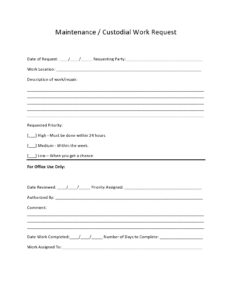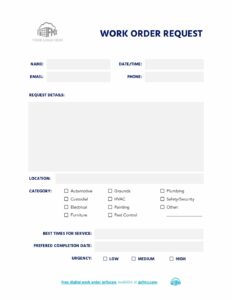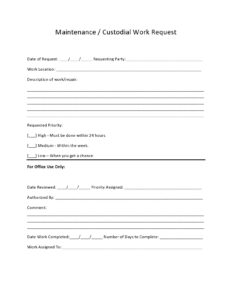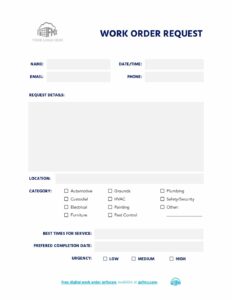Utilizing a standardized form offers several key advantages. It ensures consistent recording of essential information, reduces the likelihood of miscommunication or overlooked details, and facilitates efficient prioritization and tracking of maintenance tasks. This improved organization leads to faster response times, reduced downtime, and improved overall maintenance management.
The following sections will delve into the specific components of an effective form, best practices for its implementation, and strategies for integrating it into existing maintenance management systems.
Key Components of a Maintenance Work Order Request Form
Effective forms ensure clear communication and efficient processing of maintenance requests. Several key components contribute to this effectiveness.
1. Requestor Information: Clear identification of the individual submitting the request, including their name, department, and contact information.
2. Date and Time of Request: Accurate recording of when the request was submitted helps in tracking response times and prioritizing urgent requests.
3. Location Details: Precise information about the location requiring maintenance, including building, room number, or specific equipment identifier.
4. Problem Description: A detailed and specific description of the issue, including any observed symptoms or relevant background information.
5. Priority Level: Categorization of the request based on its urgency and potential impact on operations (e.g., low, medium, high).
6. Assigned Technician: Identification of the personnel responsible for addressing the request, facilitating accountability and streamlined communication.
7. Required Completion Date: Specification of the desired timeframe for completing the maintenance work, if applicable.
8. Attachments: Provision for including supporting documentation, such as photos or videos, to provide further context and clarity.
These elements provide a comprehensive framework for documenting maintenance needs, enabling efficient tracking, prioritization, and resolution of reported issues. Accurate and complete information in each field contributes to streamlined workflows and effective maintenance management.
How to Create a Maintenance Work Order Request Template
Creating a standardized template ensures consistency and efficiency in handling maintenance requests. The following steps outline a structured approach to developing such a template.
1: Define Required Information: Determine the essential data points to be captured on the form, such as requestor details, location, problem description, priority level, and assigned technician. Consider industry best practices and specific organizational needs.
2: Choose a Format: Select a suitable format for the template, whether digital (e.g., spreadsheet, online form) or physical (paper-based). Digital formats offer advantages in terms of data management and accessibility.
3: Design the Layout: Structure the template logically, grouping related information and using clear labels for each field. Ensure sufficient space for detailed descriptions and any necessary attachments.
4: Implement Input Validation: For digital forms, incorporate input validation to ensure data accuracy and consistency. This can include mandatory fields, dropdown menus for standardized selections, and date/time pickers.
5: Establish a Workflow: Define the process for submitting, reviewing, and approving work order requests. Clear roles and responsibilities should be assigned to ensure timely processing and completion of tasks.
6: Train Personnel: Provide training to all relevant personnel on how to use the new template and adhere to the established workflow. This ensures proper utilization and maximizes the benefits of the standardized system.
7: Test and Refine: Pilot test the template and workflow to identify any areas for improvement. Gather feedback from users and make necessary adjustments to optimize efficiency and usability.
8: Regularly Review and Update: Periodically review and update the template to reflect evolving operational needs and incorporate feedback from users. This maintains the template’s relevance and effectiveness over time.
A well-designed template, combined with a clear workflow and adequate training, forms the cornerstone of a proactive and effective maintenance management system. This structured approach minimizes downtime, optimizes resource allocation, and contributes to the overall reliability and longevity of assets.
Standardized forms for requesting maintenance work offer a crucial framework for effective facility and equipment management. From detailed problem descriptions and location specifics to prioritized urgency levels and assigned technicians, these forms ensure clarity and accountability throughout the entire maintenance process. Implementing structured templates, coupled with well-defined workflows, empowers organizations to track, manage, and address maintenance needs efficiently, ultimately minimizing downtime and optimizing resource allocation.
Effective maintenance management is an ongoing endeavor, requiring consistent evaluation and refinement of processes. Adopting and continuously improving processes surrounding work order requests contributes significantly to enhanced operational efficiency, cost savings, and prolonged asset lifespan. Organizations committed to proactive maintenance strategies will undoubtedly reap the rewards of improved performance and reduced operational disruptions.



